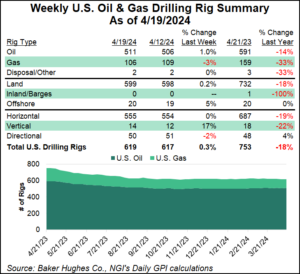August Natural Gas Futures Extend Rally as Heat Outlook Further Intensifies
- Natural gas futures posted another solid advance as optimism intensified that summer heat will drive strong energy demand
- A day earlier the prompt month surged 16.5 cents
- Forecasts call for strong heat through mid-July across most of the Lower 48
Natural gas futures posted another solid advance Tuesday as optimism intensified that summer heat will drive strong energy demand and support prices. The August Nymex contract rose 4.2 cents day/day and settled at $1.751/MMBtu. A day earlier the prompt month surged 16.5 cents.

September climbed 3.5 cents to $1.789. NGI’s Spot Gas National Avg. was flat at $1.585.
Bespoke Weather Services said forecasts for seasonally robust heat that sparked Monday’s rally “nudged” even warmer Tuesday, with the first half of July projected to be among the hottest on record in terms of total national gas-weighted degree days (GWDD).
“The core of strongest anomalous heat remains focused toward the Midwest, but does expand into the East at times, and even the southern U.S. has moved a little hotter,” the forecaster said of early July. “A hot pattern is certainly no surprise given the transition into a La Niña base state, but this level of heat is quite extreme” with 90s and 100s common across large swaths of the country.
Looking out two weeks and beyond, above average temperatures are expected to persist, Bespoke said. “Given that the pattern still looks to run hotter than normal beyond day 15, we cannot rule out challenging 2011 and 2012 for the highest July GWDD total of all time.”
Bespoke noted that balance data heading into Tuesday’s trading session was little changed, with production down modestly and liquefied natural gas (LNG) slightly lower, “essentially canceling out” each other, while power burns “continue looking strong on an absolute basis.”
Domestic weather-driven demand and power burns are squarely in focus, in part, because of weak LNG feed gas demand and anemic U.S. export levels amid the economic downturn caused by the coronavirus pandemic. LNG remains well below pre-coronavirus levels, with dozens of order cancellations from important pre-pandemic export destinations reported in recent weeks.
Against that backdrop, power burns may play a vital role in tightening the market, Energy Aspects said Tuesday.
Output from gas generators in the week ended June 26 “approached levels seen only on a handful of days last July and August — a glimpse of what could be ahead on warmer-than-normal days this summer,” the firm said. “The higher gas burn intensity year/year needs to occur to mop up excess supplies due to continued LNG cargo rejections and still-recovering industrial and overall power demand.”
Skepticism on the LNG front is likely to persist in July, as virus outbreaks continue to flare and case tallies mount in the United States and globally, weighing down economic activity and industrial energy demand.
“There is still a lot of uncertainty in the outlook,” said Raymond James & Associates Inc.’s chief economist Scott Brown. He noted that the U.S. economy — and others globally — recovered some ground in May and early June as states lifted social distancing restrictions and allowed more businesses to open.
However, “improvement after the initial rebound will slow, barring a vaccine or effective treatment,” as several states are now grappling with new virus outbreaks and are pausing or slowing their reopening plans. “There are significant challenges in the second half of the year and the risks remain weighted predominantly to the downside,” Brown said.
Beyond weather and coronavirus, traders will next turn their attention to the U.S. Energy Information Administration’s (EIA) next storage report on Thursday.
The EIA’s previous report for the week ended June 19 showed an injection of 120 Bcf, reflecting in part seasonally mild weather in the covered week. The build lifted inventories to 3,012 Bcf, put stockpiles well above the five-year average of 2,546 Bcf, and sent gas futures spiraling down to a 25-year low.
For the week ending June 26, however, early estimates call for a double-digit injection that reflects increasing summer heat and greater cooling demand. Bespoke looks for an injection of 75 Bcf.
“It is tougher to argue a bearish view as long as heat stays this strong,” the firm said.
Cash Breaks Even
Spot prices increased across much of the Lower 48 amid forecasts that called for strong July heat. There were notable exceptions, including markets in California and Appalachia.
“Upper high pressure will stretch from Texas to the Great Lakes and across the rest of the southern U.S. with very warm to hot highs” the first few days of July, said NatGasWeather. “Cooler exceptions will occur over the Northwest and New England as weather systems stall with showers and highs of 60s and 70s for locally light demand.
“The Fourth of July weekend will remain very warm to hot over most of the U.S. with highs of upper 80s to 100s besides the far northwest and northeast corners. Showers are likely over the Southeast but still very warm and humid.”
Looking out to the second week of July, the forecaster said, “upper high pressure will rule much of the U.S. with highs of 80s to 100s for strong demand…The focus remains on how long this bullish U.S. pattern lasts, and we continue to expect through at least mid-July. This should surge national power burns into the 40s Bcf/day, while providing the first test to see if all-time highs will be met or exceeded this summer.”
In the Southeast, spot prices at Texas Eastern M-1, 30 jumped 15.5 cents day/day to average $1.665, while in the Northeast, PNGTS surged 29.0 cents to $2.150.
In East Texas, Tolar Hub advanced 8.5 cents to $1.600, and in the Midcontinent, El Paso Anadarko climbed 7.0 cents to $1.510.
Those losing ground included Dominion North, down 5.5 cents to $1.450, and SoCal Citygate, off 10.0 cents to $1.665.
© 2024 Natural Gas Intelligence. All rights reserved.
ISSN © 2577-9877 | ISSN © 2577-9966 |


